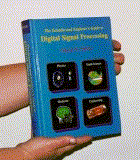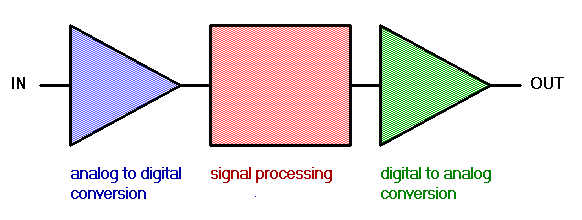
|
| Speed | optimum bandwidth | SNR vs. 12WPM |
| 12WPM | 10Hz | 0dB |
| 8WPM | 6.67Hz | +1.8dB |
| 4WPM | 3.33Hz | +4.8dB |
| 1 sec./dot | 1Hz | +10dB |
| 3 sec./dot | 0.33Hz | +14.8dB |
| 10 sec./dot | 0.1Hz | +20dB |


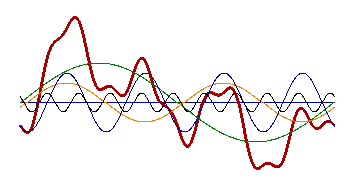
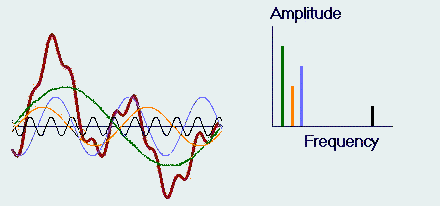
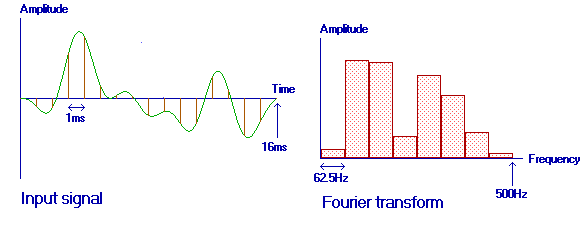
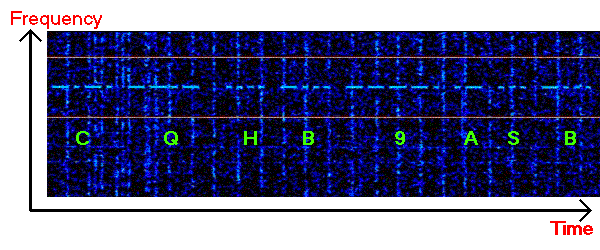
| Signal strength at RX input | Comment |
|---|---|
| -100dBu / -91dBm | good audible CW (S6) |
| -110dBu / -101dBm | CW signal equal to noiselevel (S4), can just be copied |
| -115dBu / -106dBm | boundary for aural CW, signal just detectable by ear |
| -125dBu / -116dBm | perfect readable QRSS signal ('O' report) |
| -130dBu / -121dBm | good readable QRSS signal ('M' report) |
| -135dBu / -126dBm | just detectable QRSS signal ('T' report) |
| -140dBu / -131dBm | signal not detectable |
| Dotlength | Screenshot | Measured level (vs. 6WPM) | Theoretical level (vs. 6WPM) |
|---|---|---|---|
| 0.2 sec. (6 WPM) |  | reference | reference |
| 3 sec. |  | -10dB | -11.8dB |
| 10 sec. |  | -15dB | -17dB |
| 30 sec. |  | -19dB | -21.8dB |
| 60 sec. |  | -23dB | -24.8dB |
| Dotlength | Power into antenna | Improvement vs 12WPM CW | Theoretical value |
|---|---|---|---|
| 0.1 sec. (12WPM) | 360mW | reference | reference |
| 3 sec. | 23mW | 12dB | 14.8dB |
| 10 sec. | 3.9mW | 19.7dB | 20dB |
| 60 sec. | 0.6mW | 27.8dB | 27.8dB |





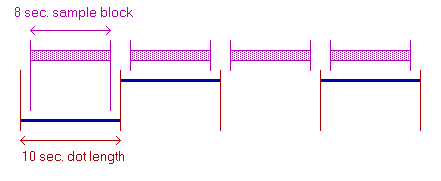
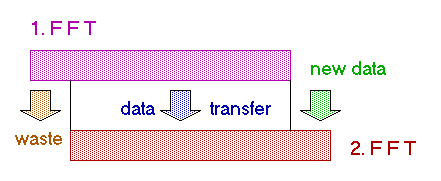
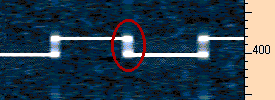
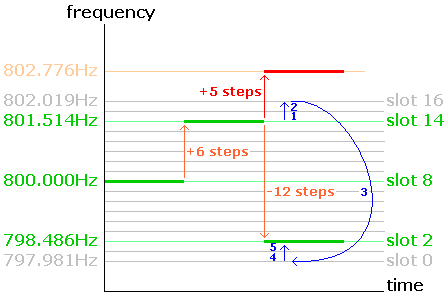
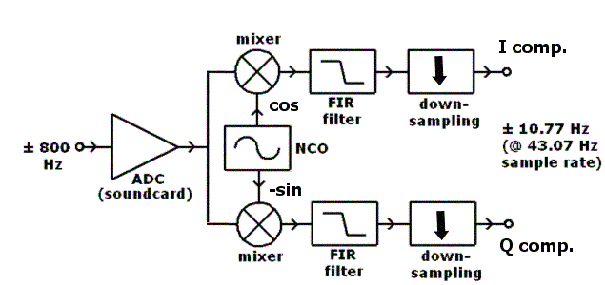
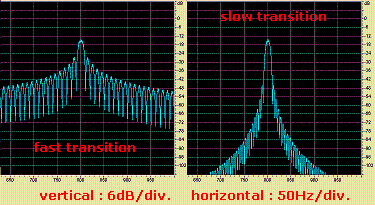 WOLF is in fact a BPSK signal at 10 bits per second. As a result the theoretical bandwidth is 10Hz, but depending on how the BPSK modulation is performed sidebands up to a few 100Hz can be quite strong and can be annoying to other LF hams living in your area. Fortunately WOLF provides the possibility to increase the transition time of the phase shift, what will reduce the sidebands significantly (picture at the right).
WOLF is in fact a BPSK signal at 10 bits per second. As a result the theoretical bandwidth is 10Hz, but depending on how the BPSK modulation is performed sidebands up to a few 100Hz can be quite strong and can be annoying to other LF hams living in your area. Fortunately WOLF provides the possibility to increase the transition time of the phase shift, what will reduce the sidebands significantly (picture at the right).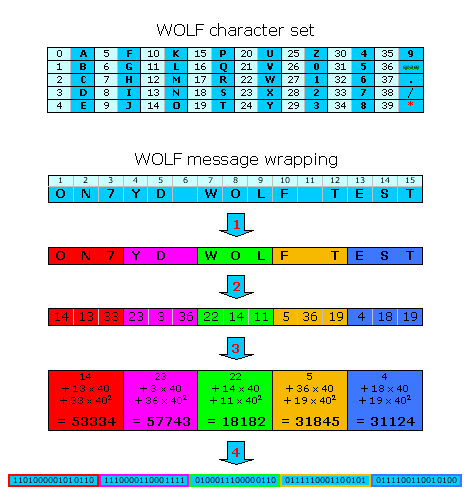 Next the 15 character message is split up 5 groups of each 3 characters. If any possible combination of 3 characters is taken into account you have 64000 possible combinations (40 x 40 x 40). Thus each group fits into a 16 bit word (216 = 65536), so the 5 groups (of each 3 characters) fit in a 80 bit data packet. Even though no real compression is done the 15 character message is wrapped efficiently into 80 bits.
Next the 15 character message is split up 5 groups of each 3 characters. If any possible combination of 3 characters is taken into account you have 64000 possible combinations (40 x 40 x 40). Thus each group fits into a 16 bit word (216 = 65536), so the 5 groups (of each 3 characters) fit in a 80 bit data packet. Even though no real compression is done the 15 character message is wrapped efficiently into 80 bits.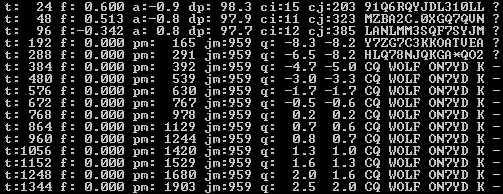
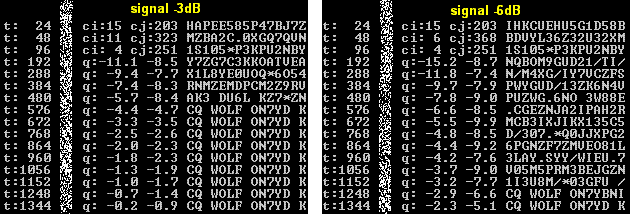
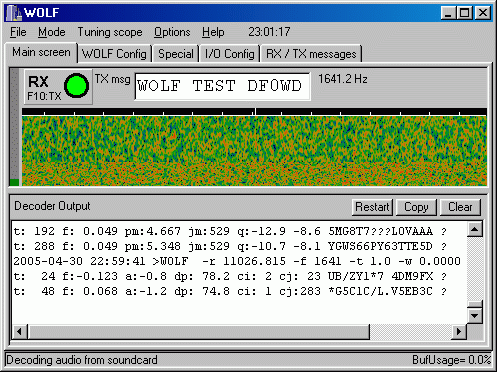
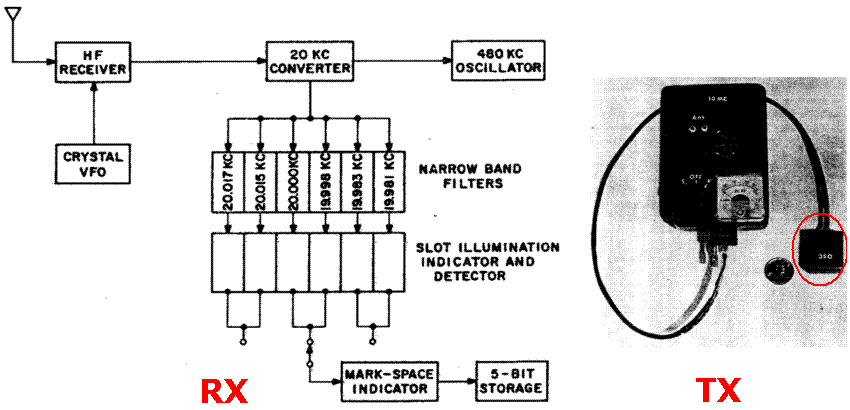
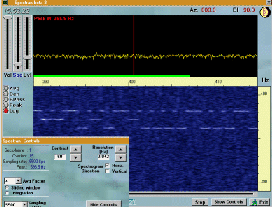
| Function | : | DSP receiving software |
| Operating system | : | Windows 95/98 |
| Author(s) | : | A. di Bene (I2PHD) and V. De Tomasi (IK2CZL) |
| Description | : | This program allows extreme narrowband reception of weak signals. A lot of option, but they require some experience to use them proper. |
| Status | : | Freeware |
| Web page | : | here |
| Download | : | version 2 |
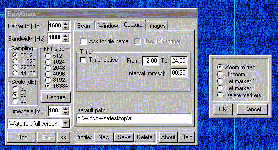
| Function | : | DSP receiving software |
| Operating system | : | Windows 95 and up |
| Author(s) | : | P. Maly (OK1FIG) |
| Description | : | This program extends possibilities of well-known Spectrogram with some new useful features. It enables to define the scrolling area to any size, it can save screen shots in defined time periods (useful overnight), it enables to browse the saved pictures easily. All the settings can be saved to named profiles. |
| Status | : | Freeware |
| Web page | : | here |
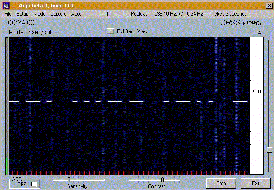
| Function | : | DSP receiving software |
| Operating system | : | Windows 95 and up |
| Author(s) | : | A. di Bene (I2PHD) and V. De Tomasi (IK2CZL) |
| Description | : | Especially developed for reception of QRSS signals at 3 sec./dot and 10 sec./dot. Easy to use, since only very few parameters have to be set. |
| Status | : | Freeware |
| Web page | : | here |
| Download | : | beta 1, build 113 |
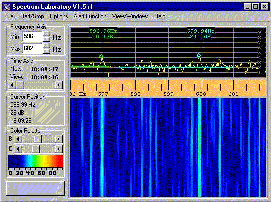
| Function | : | DSP receiving software |
| Operating system | : | Windows 95 and up |
| Author(s) | : | W. B�scher (DL4YHF) |
| Description | : | Spectrum Lab incorporates a amazing number of features in a single program. Besides the 'standard' DSP rceiving window you can use it as a terminal for PSK, RTYY etc... and it will even allow you to decode the DCF77 signal and set your PC clock to it. |
| Status | : | Freeware |
| Web page | : | here |
| Download | : | here |
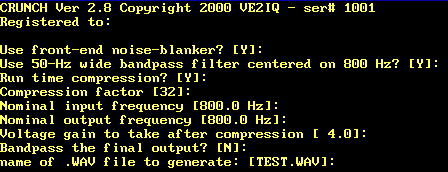
| Function | : | DSP receiving software |
| Operating system | : | DOS |
| Author(s) | : | B. de Carle (VE2IQ) |
| Description | : | A completely different approach to 'decode' QRSS transmissions is made by VE2IQ. With crunch the incoming audio signal is recorded as a WAV-file, either using the soundcard or VE2IQ's Sigma-Delta DSP board. Afterward the file is filtered and 'speeded up' to bring the QRSS signal to normal speed CW, audible via the soundcard. |
| Status | : | Freeware |
| Web page | : | |
| Download | : | here |
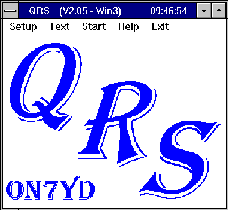
| Function | : | QRSS and DFCW transmitting software |
| Operating system | : | Windows 3.11 and up |
| Author(s) | : | R. Strobbe (ON7YD) |
| Description | : | This program is primarily intended to be used for QRSS and DFCW but has also some normal CW facilities. Keying of the transmitter and frequency shifting (for DFCW) is done via the serial or parallel port, using a very simple interface. Various options are available, including QSK and fast CW identification in QRSS and DFCW modes. In 'QSO mode' the program is optimized to share the screen with receiving software. Version 3.17 is Win3 compatible but will not support the parallel port under WinNT, Win2000, WinXP etc. Version 4.02 has full support of the parallel port but requires at least Win98. |
| Status | : | Freeware |
| Web page | : | here |
| Download | : | version 3.17 : here version 4.06 : here |
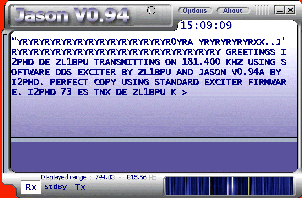
| Function | : | Jason transmitting and receiving software |
| Operating system | : | Windows 98 and up |
| Author(s) | : | A. di Bene (I2PHD) |
| Description | : | a keyboard-to-keyboard communication program, tailored for very low S/N ratios, based on the IFK technique, using only 4 Hz bandwidth. |
| Status | : | Freeware |
| Web page | : | here |
| Download | : | here |

| Function | : | software to generate and decode WOLF audio files |
| Operating system | : | DOS |
| Author(s) | : | S. Nelson (KK7KA) |
| Description | : | software to generate and decode WOLF audio files. Not suited for real time operation (see WOLF GUI for that) |
| Status | : | Freeware |
| Web page | : | here |
| Download | : | here |
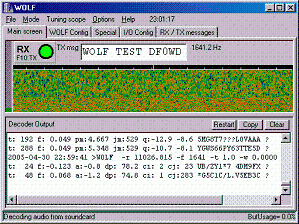
| Function | : | GUI (graphic user interface) for KK7KA's WOLF software |
| Operating system | : | Windows 98 and up |
| Author(s) | : | W. B�scher (DL4YHF) |
| Description | : | GUI for real time generation and decoding WOLF signals |
| Status | : | Freeware |
| Web page | : | here |
| Download | : | here |
